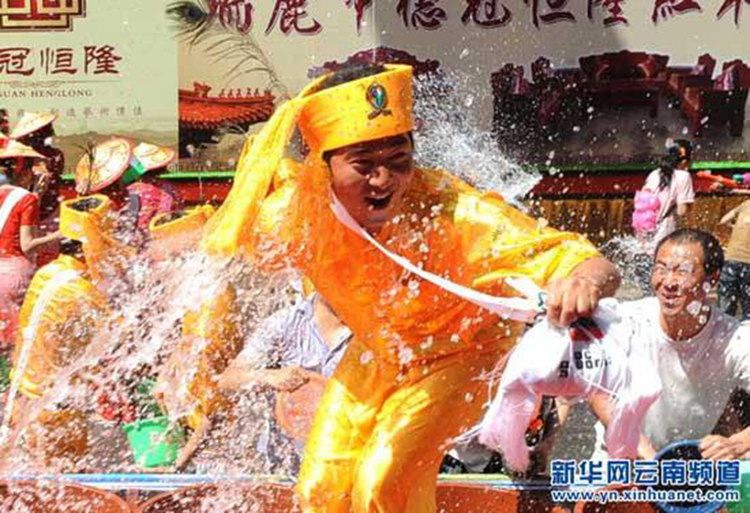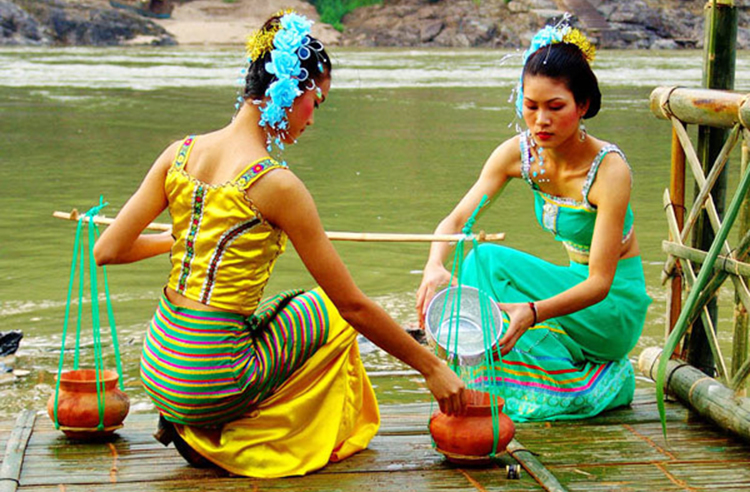Written by: Gulibahar
Posted on: September 08, 2016 |  | 中文
| 中文
Dances performed by Dai People at the China Folk Culture Village, Shenzhen
The Dai people in China, with a population of 1.16 million, live primarily inthe Yunnan Province. The region where the Dai people live is verdant all year round and has abundant rainfall, fertile soil and a beautiful landscape. Hence, people enjoy living here, engaging themselves primarily in cultivating grains and economic crops. The Dai culture and art is time-honored and glittering. The Dai calendar absorbs elements from the astronomical calendar in the Central Plains and India, but has evolved into a system of its own. The literature of Dai people is dazzling, integrating poetry, tales, stories and fable. The traditional long narrative poems amount to around 500 in number. The Water Splashing Festival of the Dai people is ceremonial, popular and highly entertaining.
Having a population of 1.16 million, the Dai people in China primarily inhabit the Yunnan Province. They mainly live in the flat river valley surrounded by mountains. Thanks to the subtropical climate, it doesn’t snow all year round. Abundant rainfall, fertile soil, evergreen habitat and beautiful mountains make it a perfect place to grow crops, especially economic ones such as rice, sugar cane, camphor, coffee, sisal hemp and rubber. Xishuangbanna Dai Autonomous Prefecture?one of the major Dai communities is home to the large leaf tea in Asia, also containing Pu’er tea which is well-known at home and abroad. Subtropical fruits are perennial, such as mango, coconut, pineapple, and banana. The verdant primitive forest hosts precious woods such as teakwood, red sandalwood and Chinese fan palm, along with rare medicinal plants such as rauwolfia and quinine. In the primitive forest and rolling hills and valleys in Xishuangbanna, there are rare birds and strange beasts such as the wild elephant, tiger, leopard, rhinoceros, golden monkey and peacock. Forest covers around 57.14% of the total region.

The Dai culture and art is time-honored and glittering. The Dai people have their own language which belongs to the Zhuang-Dong Austronesian of the Chinese-Tibetan Phylum. There are two dialects, namely Xishuangbanna dialect and Dehong dialect and alphabetical writing is used in the written form of the Dai language. The Dai people have made stunning achievements in astronomy, literature and art. The Dai calendar absorbs elements from astronomical calendar in the Central Plains and India but has evolved into a system of its own. It is the lunisolar calendar, consisting of 12 months, including the odd months - big months, and the end ones, denoting the small months. According to the Dai calendar, September is the leap month which appears 7 times in 17 years, and the last day of the Water Sprinkling Festival marks the beginning of a new year. “The Twelve Months Song” popular in the Dai communities is not only a folk song, but also a text with rich information about agriculture and meteorological solar terms.
The Dai literature is dazzling, integrating poetry, tales, stories and fable with the traditional long narrative poems amounting to around 500. The traditional long narrative poems are of various themes, eulogizing the evolution of the human species, achievements by the Dai ancestors, representing historical events, exposing social conflicts through love stories and presenting the Dai people’s new life after the founding of the People’s Republic of China. Dai people love singing and dancing. Peacock dance accompanied by elephant-foot drum and gong, is of unique ethnic charm and draws audience at home and abroad. With the introduction of Buddhism into the Dai communities, the architecture here shows the Buddhist influence. Buddhist temples are seen interspersed around the Dai communities, showing exquisite and elegant skills in sculpture and paintings. The awe-inspiring temples and pagodas can be seen over the bamboo bridges, presenting distinctive architectural appeal.
The traditional costume of the Dai people is quietly elegant and beautiful, serving well the practical and decorative functions. It speaks vividly of their passion for life and pursuit of harmony. Dai men wear collarless tight-sleeved short jackets, with the opening at the front or along the right side, and long baggy pants. In the winter, they drape a felt blanket over their shoulders and wrap their heads with white or black cloth. The Dai women’s traditional costume includes jacket with tight sleeves and straight skirt covering the insteps. The Dai women’s costume in Yunnan is generally similar, yet there are distinctive local features as well. That’s why the Dai people are named Huayao Dai or Daxiu Dai based on their costume, emphasizing the floral wrist design of the formers attire and the large sleeves of the latter. The Dai women’s costume is designed to show their graceful figure. Dai women like wearing long hair and have various ways of making their hair beautiful and unique. They decorate their hair with comb or flowers, scarf, high hat or large bamboo hat.

Rice is the staple food for the Dai people. In Dehong, people love eating japonica rice, whereas in Xishangbanna people favor glutinous rice. There is a variety of food that Dai people make with glutinous rice. The Dai people in Xishangbanna enjoy steaming rice more than the boiled rice to make it tastier. They also enjoy cooking rice in bamboo and heating it over ashes. When the rice is fully prepared, it looks like crystal and smells tempting. The Dai people enjoy food with sour flavor and drink homebrew light wine. Betel nuts are also something they quite enjoy.
Dai villages are mostly seen in flat areas near water, bamboo trees and streams surrounded by beautiful scenery. The Dai bamboo housing is mostly built entirely of bamboo. When one walks into the Dai communities, rich subtropical scenery embraces ones eyesight. Bamboo buildings in the jungle and abundant grass are eye-catching and are capable of impressing the outsiders with unforgettably fresh surroundings.
In Xishuangbanna, all villagers come to help when a family decides to build its house. Upon completion, they all come to the house-warming party to celebrate. Young men are the first to go upstairs with a cow’s head, singing blessing songs. Male adults bring the boxes, and married women carry the bedding, whereas the girls bring food and then have it set the table, singing songs of celebration. Villagers bring some auspicious gifts to the host. In Dehong Dai and Jingpo Autonomous Prefecture, most Dai people live in bungalows which are quadrangular.

Before getting married, the Dai youth are free to socialize and find their love. The uxorilocal customs are popular among them. At the wedding, the grand custom of “tying” is observed when a white cotton thread is used to tie the bride and groom by the wrist to symbolize that they are bonded and then are blessed them with a prayer for a harmonious and long life together.
The Dai people believe in Theravada Buddhism in general, which exerts a great influence on their daily life and customs.
The Dai people’s festivals are closely related to religion. The Water Splashing Festival in June is regarded as the New Year in the Dai calendar. It is the grandest festival which includes activities such as water-splashing, dragon-boat race and sending off skyrockets (made of bamboo and gunpowder, similar to fireworks). Other important festivals are door-closing festival and door-opening festival. Three months between the two festivals feature most of the Buddhist activities, including paying homage to Buddha and listening to Buddha’s preaching. Things go back to normal after the festivals.
After the founding of the People’s Republic of China, particularly after the implementation of reform and opening-up policies, Dai people have witnessed great development in economy and culture. The advantages of tropical economic crops, such as rubber, tea and sugar cane and coastal location are fully explored. Border trade developed rapidly. Xishuangbanna Airport opened in April 1990 opened domestic routes to Chengdu, Guangzhou, Chongqing and Tianjin and international routes to foreign cities such as Bangkok. It is the second largest airport in Yunnan, next only to Kunming. The region where the Dai people live is prosperous, beautiful and bountiful, matching its nickname, “home of the peacock.”
You may also like: